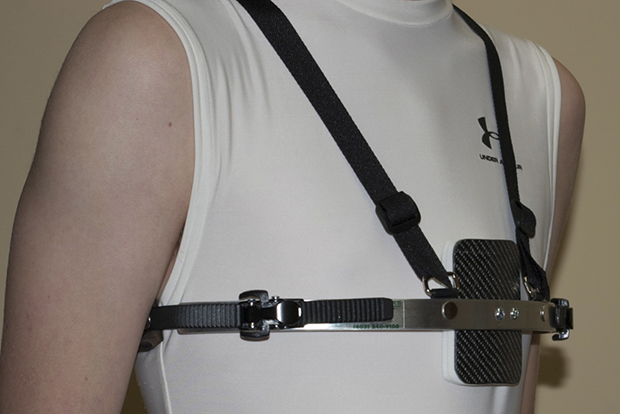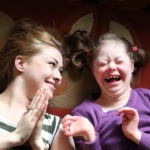Bracing is an effective therapy for pectus carinatum: interim results
If patients are compliant, a self- adjusting brace system can give rapid correction of the pectus carinatum protrusion with excellent patient satisfaction.
These interim results suggest that continued bracing until skeletal maturity gives long term durability to the correction. Further studies will be required to further refine this promising therapy.
| BACKGROUND |
Pectus Carinatum is a common congenital chest wall malformation. Until recently, the mainstay of treatment was surgical remodeling of the deformed chest wall.
Initial results suggest that non-operative bracing may be an effective therapy, but the optimal strategy for correction is not known.
Herein we report the results of a self-adjustable low profile bracing system worn continuously until the defect is corrected (correction phase), then worn at night (8 h/day) until completion of axial growth (maintenance phase) – the Calgary Protocol.
| METHODS |
Patients referred to a pediatric surgery chest wall clinic were prospectively asked to join an IRB approved outcomes monitoring study.
124 patients were evaluated from 2007 to 2011, and 98 were prescribed a brace and counseled to follow the protocol.
| RESULTS |
98 patients consented to follow-up at starting bracing age: 14.4 ± 1.9 years, Tanner stage: 3.6 ± 0.5, protrusion: 2.1 ± 1.0 cm, self-rating of appearance: 2.9 ± 1.1, and exercise tolerance: 4.4 ± 1.1 (1-5 with 5 = normal).
10 patients are in correction phase, and 44 patients have completed correction after 7.0 ± 7.3 months: Tanner stage: 3.8 ± 0.1, protrusion: 0.5 ± 0.6 cm*, appearance: 4.3 ± 0.3* and exercise tolerance 4.6 ± 1.0.
Correction occurred more quickly in patients prior to achieving Tanner stage IV (4.2 ± 0.9 months) vs. Tanner stage IV (8.0 ± 7.1 months) at the beginning of bracing. 21 patients completed maintenance bracing after 17.9 ± 19.0 months: Tanner stage: 3.9 ± 0.2, protrusion 0.5 ± 0.7 cm*, appearance: 4.3 ± 0.9*, and exercise tolerance: 4.8 ± 1.4. Average follow-up after bracing is 13.9 ± 16.0 months (mean ± S.D., *P < .05).
There was one recurrence, likely due to early discontinuation of maintenance. This responded to an additional 6 months of bracing. 42 patients failed therapy secondary to non-compliance or were lost in follow up, while 2 patients did not respond to bracing and required open operation.
| CONCLUSIONS |
If patients are compliant, a self- adjusting brace system can give rapid correction of the pectus carinatum protrusion with excellent patient satisfaction.
These interim results suggest that continued bracing until skeletal maturity gives long term durability to the correction. Further studies will be required to further refine this promising therapy.
| References |
JPS_Article_2013-01
Bracing is an effective therapy for pectus carinatum: interim results, Lee RT, Moorman S, Schneider M, Sigalet DL, J Pediatr Surg. 2013 Jan;48(1):184-90. doi: 10.1016/j.jpedsurg.2012.10.037.
The Calgary protocol for bracing of pectus carinatum: a preliminary report, Kravarusic D, Dicken BJ, Dewar R, Harder J, Poncet P, Schneider M, Sigalet DL. J Pediatr Surg. 2006 May;41(5):923-6. doi: 10.1016/j.jpedsurg.2006.01.058. PDF
| Further reading |
Compressive orthotic bracing in the treatment of pectus carinatum: the use of radiographic markers to predict success, Stephenson JT, Du Bois J. J Pediatr Surg. 2008 Oct;43(10):1776-80. doi: 10.1016/j.jpedsurg.2008.03.049.
Nonoperative correction of pectus carinatum with orthotic bracing, Banever GT, Konefal SH, Gettens K, Moriarty KP. J Laparoendosc Adv Surg Tech A. 2006 Apr;16(2):164-7. doi: 10.1089/lap.2006.16.164.
Compressive orthotics in the treatment of asymmetric pectus carinatum: a preliminary report with an objective radiographic marker, Egan JC, DuBois JJ, Morphy M, Samples TL, Lindell B. J Pediatr Surg. 2000 Aug;35(8):1183-6. doi: 10.1053/jpsu.2000.8724.







